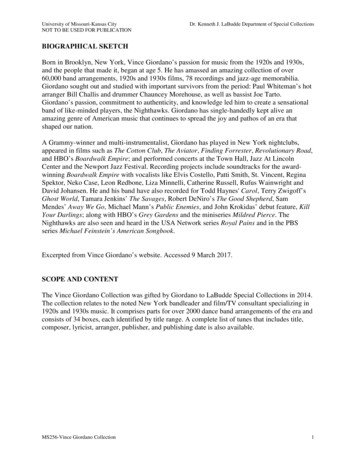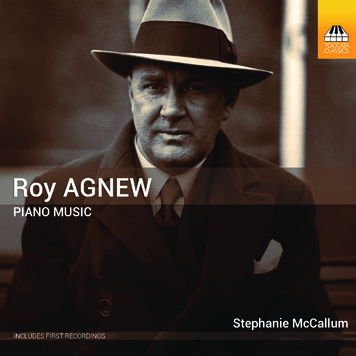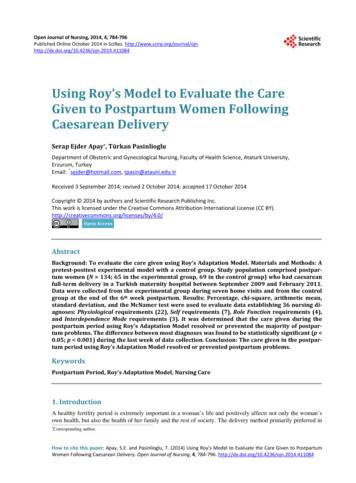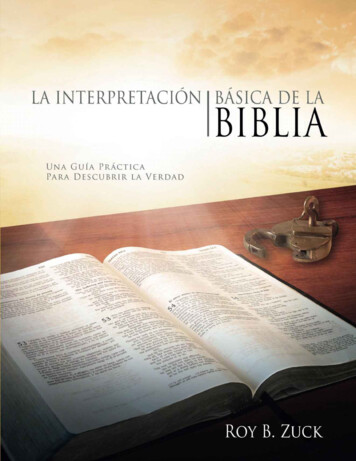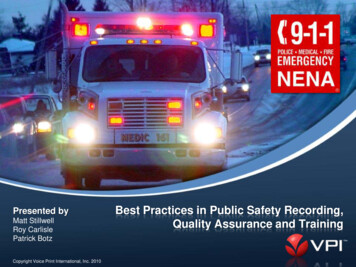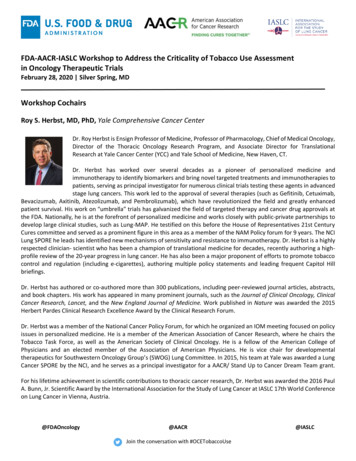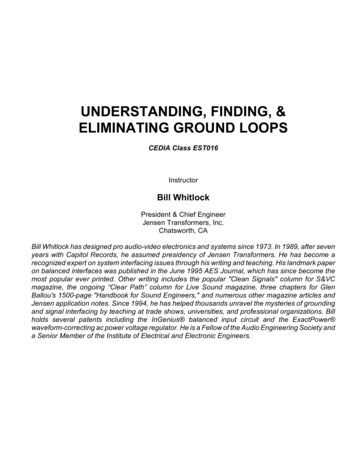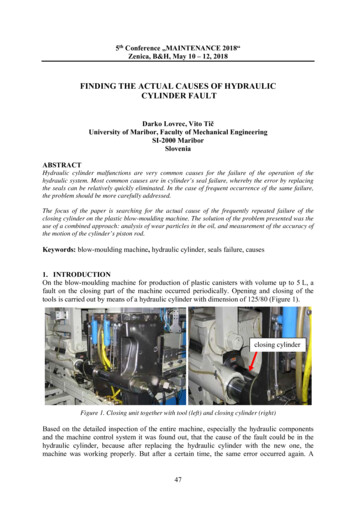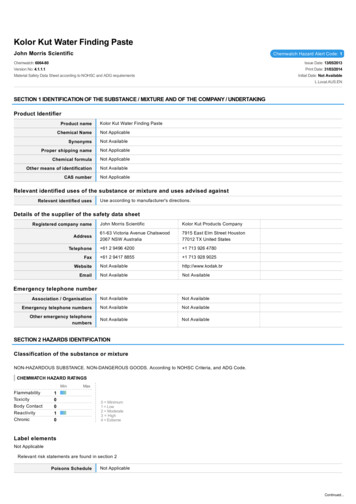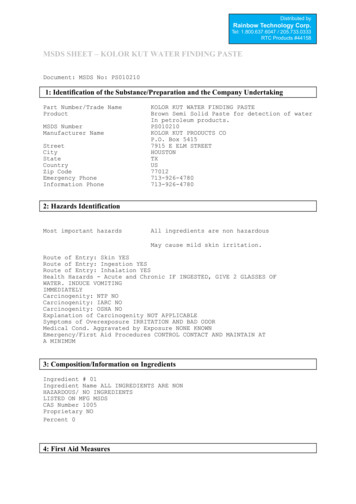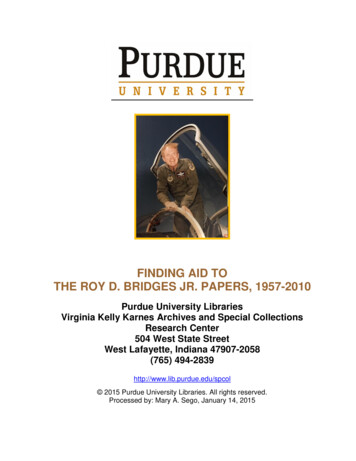
Transcription
FINDING AID TOTHE ROY D. BRIDGES JR. PAPERS, 1957-2010Purdue University LibrariesVirginia Kelly Karnes Archives and Special CollectionsResearch Center504 West State StreetWest Lafayette, Indiana 47907-2058(765) 494-2839http://www.lib.purdue.edu/spcol 2015 Purdue University Libraries. All rights reserved.Processed by: Mary A. Sego, January 14, 2015
Descriptive SummaryCreator InformationBridges, Roy D., Jr., 1943-TitleRoy D. Bridges Jr. papersCollection IdentifierMSA 6Date Span1957-2010AbstractThis collection includes documents, photographs, awardsand certificates, textbooks, briefs and records, artifacts,audiovisual materials, and scrapbooks that document thelife and career of astronaut and retired United States AirForce Major General Roy Bridges Jr. Included arenumerous awards, drawings, and personalizedphotographs and mementos given to Bridges inappreciation of his service and leadership.Extent68.90 cubic feet (24 cubic feet boxes, 2 legal mss boxes,37 letter mss boxes, 12, ½ letter mss boxes, 6 small flatboxes, 3 medium flat and 8 large flat boxes, and 3oversized, loose wrapped items)Finding Aid AuthorMary A. SegoLanguagesEnglishRepositoryVirginia Kelly Karnes Archives and Special CollectionsResearch Center, Purdue University LibrariesAdministrative InformationLocationInformation:ASC and ASC-RAccessCollection is open for research. The collection is stored offsite; 24 hoursRestrictions: notice is required to access the collection.AcquisitionInformation:Donated by Roy D. Bridges Jr., 12/2/20152
A 6, Roy D. Bridges Jr. papers, Karnes Archives and SpecialCollections, Purdue University LibrariesCopyrightNotice:Purdue University per deed of gift. Frontline episode copyright held byPBS.RelatedMaterialsInformation:Janice Voss p?p collections/controlcard&id 1340&q janice vossJerry L. Ross p?p collections/controlcard&id 1629&q jerry ross12/2/20153
Subjects and GenresPersonsBridges, Roy D., Jr., 1943Voss, Janice, 1956-2012Ross, Jerry L., 1948Blaha, John E., 1942OrganizationsNASAAir Force (U.S.)U.S. Air Force AcademyJohn F. Kennedy Space CenterLangley Air Force Base (Va.). Langley Research CenterEdwards Air Force Base. USAF Test Pilot SchoolFlight Archives at Purdue UniversityPurdue UniversityTopicsAstronautsAir pilots (Military)Challenger (Spacecraft)Space flightsSpace shuttles--United StatesPurdue University--Alumni and alumnaeUnited States. Air Force--ManagementCentaur rocketForm and Genre TypesArtifactsAudiovisual materialsAwardsBooksBriefs and recordsCassettes, ariesLogs 12/2/20154
d States. Air Force--Medals, badges, decorations, etc.VHSWorking papersOccupationsAstronautEngineerTest PilotUnited States Air Force Major General12/2/20155
Biography of Roy D. Bridges Jr.Roy Dunbard Bridges, Jr., was born on July 19, 1943 in Atlanta Georgia. The familylater moved to Gainesville, Georgia where Bridges grew up and graduated fromGainesville High School in Gainesville, Georgia in 1961. He won a Congressionalappointment to the United States Air Force Academy Class of 1965 and was adistinguished graduate. He won a competitive engineering graduate schoolscholarship from the United States Air Force and entered Purdue Universityimmediately following graduation from the Academy. He was awarded a Master’s ofScience from Purdue in 1966. He graduated from the United States Air ForceUndergraduate Pilot Training at Williams AFB, Arizona, as a distinguished graduatein March 1967.Assigned to Cannon AFB, New Mexico, for advanced pilot training in the F-100, hesuccessfully completed the advanced course and was assigned to the 416th TacticalFighter Squadron, Phu Cat Air Base, Republic of Vietnam, in January 1968. Hecompleted 226 combat missions prior to the end of his tour in December 1968.Included in this total are 72 missions that he flew over North Vietnam and Laos in theF-100F during a four month Commando Saber Operation, “Misty,” fast forward aircontrol assignment. This unit was focused on discovering and destroying surface toair missiles in Route Package 1, interdicting supply routes, and suppressing enemyanti-aircraft artillery fire to aircrew rescues.After his Vietnam tour, he taught flying training in the T-37 and was selected to attendthe USAF Test Pilot School (named the USAF Aerospace Research Pilot School atthe time.) In 1971, he graduated from the school with the Top Graduate Award andwas assigned to Edwards AFB to test the next generation of close air support aircraft.He was one of five Air Force test pilots that participated in the competitive fly-offbetween the YA-9 and YA-10 and stayed on after the fly-off to test the upgrades toYA-10 that would be integrated into the production aircraft. He was also selected tocomplete the YA-10 Post Stall and Spin Test Program.Following tours at Air Command and Staff College and the Pentagon, he returned toflight testing as part of the unit developing the F-117 stealth fighter. That tour wasinterrupted when he was chosen by NASA to be a Space Shuttle astronaut. Hepiloted the Challenger on the 19th Shuttle mission (STS 51-F) in July and August of1985 for 126 orbits. He was selected for another flight on the Challenger that wasscheduled for launch in May 1986.After the Challenger accident in January 1986, his mission was canceled, and he wasreassigned by the Air Force to command the Air Force’s largest test wing at EdwardsAir Force Base, California. Following his command of the test wing, he commandedthe Eastern Space and Missile Center, Patrick AFB, Florida, and the Air Force FlightTest Center, Edwards AFB, California. He also served in several key staff positionsfor the Air Force Systems Command and the Air Force Materiel Command. He retired12/2/20156
from the Air Force after 31 years of service in July 1996 as a Major General. He wasa Command Astronaut Pilot with over 4,460 flying hours in a variety of aircraft andspacecraft.Following his career with the Air Force, he was selected by the National Aeronauticsand Space Administration (NASA) to be the Center Director for the Kennedy SpaceCenter, Florida and later as the Center Director for the Langley Research Center inHampton, Virginia. He retired from the Senior Executive Service in December 2005after over 40 years of public service to the nation following his graduation from theAcademy. In 2006 he went on to become Director of Operations for NorthropGrumman Technical Services in Herndon, Virginia.Throughout his career, Bridges received numerous awards and honors. He is therecipient of the Distinguished Service Medal; Defense Superior Service Medal withoak leaf cluster; Legion of Merit with oak leaf cluster; Distinguished Flying Cross with2 oak leaf clusters; Meritorious Service Medal; Air Medal with 14 oak leaf clusters; AirForce Commendation Medal; NASA Space Flight Medal; NASA Certificate ofCommendation; and the Dr. Kurt H. Debus Award, among many other awards.Source:Per Bridges’ biography highlights found among his papers.12/2/20157
Collection DescriptionScopeThe Roy D. Bridges Jr. papers (1957-2010; 68.90 cubic feet) document the extensiveAir Force and NASA career of Roy D. Bridges Jr.The papers include but are not limited to, artifacts, audio visual material, awards,books, briefs and records, certificates, clippings, clothing, correspondence, diaries,documents, flight logs, flight checklists and data files, along with Bridges’ pilotkneeboard notes, medals, mementos, papers, photographs, scrapbooks, textbooks,research papers, and working papers.Donated in multiple accessions over several years, each accession arrived with adetailed inventory that, in many cases, included explanatory notes by Bridges. Thesenotes, a kind of commentary by Bridges, have been incorporated into this finding aid.The papers are divided into nine series, and further information on the scope andcontent of the collection is located at the series and subseries levels:Arrangement1. Education, 1960-2009 (1.6 cubic feet). Contained in this series are brochures,class photographs, correspondence, grade reports, research papers, scrapbook,textbooks, and transcripts among other items from throughout Bridges’ education.The series is arranged in chronological order and divided into four subseries, due tothe extensive nature of his education. The subseries include; Gainesville HighSchool, Gainesville, Georgia; United States Air Force Academy; Purdue University;and Student Pilot Training at Williams Air Force Base, Arizona (March 1966-March1967.)Of special note is a service project scrapbook; “Single Service Project ‘333’, KeyClub of Gainesville High School,” from Bridges’ senior year in high school. Theproject won first place at the Key Club International Convention, Philadelphia, PA,1961, the year Bridges was president of the club. Also included is correspondencefrom his high school principal and ninth grade Science teacher.Upon Bridges’ graduation from Gainesville High School, Gainesville, Georgia in 1961,Bridges attended the United States Air Force Academy. He would become adistinguished graduate of the Academy, earning a Bachelor’s degree of engineeringscience in 1965. This subseries contains various brochures, a Class of 1965photograph, research papers, Astronautics textbooks used by Bridges,correspondence, and a folder; “United States Air Force Academy visit to PurdueUniversity – School of Aeronautics, Astronautics and Engineering Sciences, February12-13, 1965.”12/2/20158
Upon his graduation from the USAFA in 1965, the Air Force sent Bridges to Purdueto earn a Master's degree. It took him only a year at Purdue to earn a Master ofScience degree in astronautics. Items of special note in this subseries are a researchreport, “Space Radiation Hazards,” written by Bridges and John Blaha (fellow Purduealum and astronaut) while students at Purdue University for Mechanical Engineering654 for which they received an A. A group research paper, “Mars Reentry Vehicle,Heat Shield Design,” written for Purdue Professor Hoglund. Other items includeBridges’ Purdue ID, parking pass, grade reports and transcripts.After Bridges’ graduation from Purdue University in 1966, he went on to student pilottraining; Williams Air Force Base, Arizona (March 1966-March 1967), F-100 pilot,524th Tactical Fighter Squadron, Cannon Air Force Base, New Mexico (March 1967November 1968), United States Air Force Test Pilot School, Edwards Air Force Base,California (1971), and he was a distinguished graduate, Air Command and StaffCollege, Maxwell Air Force Base, Alabama in 1976. He furthered his educationthroughout his career, including attending the University of New Hampshire ExecutiveDevelopment Management Program, Durham in 1988. The last subseries, StudentPilot Training, 1966-1976, include items from this segment of Bridges’ education.Among the items, but not limited to are exams and some assignments, manuals,research reports and textbooks.2. Air Force Career, 1964-1996 (16.75 cubic feet). Major General Bridges’ AirForce Career spanned 31 years. The 9 subseries follow his career path; F-100 pilot,416th Tactical Fighter Squadron and Commando Sabre Operation (Misty), Phu CatAir Base, Republic of Vietnam; Test Pilot, Air Force Flight Test Center, Edwards AirForce Base, California; Astronaut Application Process and Selection; Commander,6510th Test Wing, Edwards Air Force Base, California; Commander, Eastern Spaceand Missile Center, Patrick Air Force Base, Florida; Deputy Chief of Staff, Test andResources, Headquarters Air Force Systems Command, Andrews Air Force Base,Maryland; Commander, Air Force Flight Test Center, Edwards Air Force Base,California; Director of Requirements, Headquarters Air Force Materiel Command,Wright-Patterson Air Force Base, Ohio; and Air Force Retirement, and Span ofCareer Records.There is a description of each subseries before each section in the finding aid. Someof the items consist of: Bridges’ “Vietnam End of Tour Report,” application forAerospace Research Pilot, working files, various flight test documents, Bridges’astronaut applications, various briefings, memos and articles on the subject ofconducting Air Force test operations efficiently and safely, along with documents fromBridges’ many other numerous initiatives. One can also find newsletters,newspapers, flight logs, performance appraisals, Air Force span of career records,ending with retirement letters and cards of congratulations. Due to the extensivenature of this series, please refer to the detailed listing.12/2/20159
3. NASA Career, 1980-2010 (8.25 cubic feet). The NASA Career series iscomprised of four subseries: Astronaut Career; Director, John F. Kennedy SpaceCenter; Director, Langley Research Center; and NASA Publications.The Astronaut Career subseries features Bridges’ STS-51-F and STS 61-F “Files ofNotes and Working Papers Related to Preparation,” 1980-1986, and audio visualmaterial directly related to the two missions. Also located in the series are STS 51-Fflight logs, flight checklists and data files, along with Bridges’ pilot kneeboard notesand cards. A few items that can be seen from the STS 61-F, Centaur mission areBridges’ “Deficiencies and Notebook” which he was preparing to take to orbit, and asmall black notebook, which contains, per Bridges, “notes on meetings and issuesfrom the time of the Challenger mishap until I left the astronaut program to becomeWing Commander at Edwards AFB (Jan-May 1986). Most of the meetings had to dowith issues with the Centaur upper stage that was to launch Ulysses into polar orbitaround the sun. Rounding out the Astronaut Career subseries are issues of thenewsletter, Space News Round-up,” NASA Lyndon B. Johnson Space Center,August 9, 1985 – June 13, 1986.The second subseries, Director, John F. Kennedy Space Center, covers manyannual reports, briefing charts, implementation plans, strategic plans, reorganizationdocuments and other papers from Bridges’ tenure as Director, 1996-2002. Pleaserefer to the listing in the finding aid for material in this subseries.The third series, Director, Langley Research Center, includes Backup Discs (6) forEmail and Files from Duties at Langley Research Center (Mac/Eudora Email),“Speeches,” Briefings, NASA Engineering and Safety Center (NESC) papers, andMiscellaneous Documents.The last subseries within Series 3. NASA Career is Subseries 4. NASA Publications.Found here are various NASA Publications that Bridges had collected over the years,1978-2008. The publications are arranged in chronological order in archival boxes.4. Career Scrapbooks, 1965-2009 (11 cubic feet). The career scrapbooks consistof an extensive collection of three-ring binders that Bridges put together throughouthis Air Force and NASA careers. For the sake of archival integrity, the binders havebeen left in the order in which Bridges had arranged them. There are 31 binders thathave been arranged in 2 subseries; Air Force and NASA and are further broken downinto 11 sub-subseries which follow his career path. The contents of each page withinthe binders is listed in the finding aid. If Bridges provided a comment about thecontents, this is noted in the finding aid too.There is a wealth of material that is contained in the binders. Some of the items are:applications, appraisals, certificates, correspondence and letters of congratulations,notification of appointments, speaking notes, and various notes, emails, cards andmiscellaneous items from his retirement. The binders also include photographs from12/2/201510
throughout his career, some signed and inscribed to Bridges. There are alsophotographs from the very first Space Shuttle flight.One binder contains mission patches and astronaut autographs given as a departuregift from Kennedy Space Center by the Astronaut office in 2003. Four binders aredevoted to Bridges’ work on the Columbia Accident Investigation Board and MaterialRelated to Public testimony to Columbia Accident Investigation Board, 2003. Pleasesee the finding aid for further information and a detailed listing of items found withinthe 31 binders contained in this series. Since several binders reside in each box,look for a binder level description of contents versus box level.5. Audio Visual, 1968-2007 (5.6 cubic feet). The audio visual material consists ofa wide range of media and topics. It has been arranged by type of media (VHS,DVDs, CDs, audio tapes, and films) and placed in chronological order within eachtype. Some of the highlights are military Change of Command ceremonies, SpaceShuttle related events, Bridges’ “Last Flight at Edwards Air Force Base,” apresentation by Bridges on the future of Kennedy Space Center, various Purdueastronaut alumni events, along with the Purdue University 2001 commencementceremony when he received an honorary doctorate.Also included are a PBS Frontline, “The Real Stuff,” segment (reproduction isprohibited), “Cool Digs,” a segment for “Newsstand” based on a tour of Bridges’ officewhile he was Center Director of the NASA Kennedy Space Center, May 15, 2000,and “CAIB (Columbia Accident Investigation Board) Report Media Briefing,” August26, 2003. Due to the variety of topics, please refer to the listing within the finding aid.6. Books and Journals, 1976-2010 (1 cubic foot). This series contains selectedbooks and journals from Roy D. Bridges’, Jr. personal library. Many of the books areof a historical nature relating to Air Force and NASA facilities, and aerospace andaeronautics in general. The book, Colorado’s astronauts: In their own words, featuresBridges on pages 18-20, along with his original submission for the book.Many of the journals contain articles on the Space Shuttle, including the first launch,STS-1 of Space Shuttle Columbia on April 20, 1981.Materials in the series are arranged in chronological order, with the books andjournals in separate manuscript boxes.7. Photographs, 1965-2010 (5.70 cubic feet). This series is comprised of threesubseries: Air Force; NASA; and Oversized (16” x 20” matted). There are eight subsubseries with each described before their respective listings.The earliest Air Force photographs feature Bridges in Cadet Wing Staff uniform,training class group photographs, and photographs from Vietnam and CommandoSabre Operation (Misty), Phu Cat Air Base, Republic of Vietnam, 1968. Also found inthis series is a photo album which was presented to Bridges in July 1975 by Test12/2/201511
Operations on his departure from Edwards Air Force Base, California. It containsphotographs of colleagues with inscriptions to Bridges. Other photographs fromBridges’ Air Force career include a 419 Test Wing activation ceremony, Edwards AirForce Base, at which Bridges gave all new squadrons their flags at the ceremony,and photos from a Change of Command ceremony, Eastern Space and MissileCenter, Patrick Air Force Base, Florida (1989-1990). Going Away and Legion of Meritceremonies, while Bridges served as Deputy Chief of Staff, Test and Resources,Headquarters Air Force Systems Command. The Air Force subseries ends withnumerous photographs from Bridges’ visit to the French Air Force Test Facilities in1992 and Major General Grouvalle’s follow-up visit to the USAF Test Facilities,Edwards AFB, CA.The highlights of the NASA subseries are of Bridges’ career as an astronaut, andinclude his official astronaut photograph, including one in civilian clothes. There arevarious STS-51 crew and mission photographs, STS-61F crew photos and one of thelaunch of the Atlas/Centaur-66. There are 2 photo albums with the NASA seal and“Langley Research Center, Roy D. Bridges, Jr.,” on the cover with various photos
12/2/2015 2 Descriptive Summary Creator Information Bridges, Roy D., Jr., 1943- Title Roy D. Bridges Jr. papers Collection Identifier MSA 6 Date Span 1957-2010 Abstract This collection includes documents, photographs, awards an
